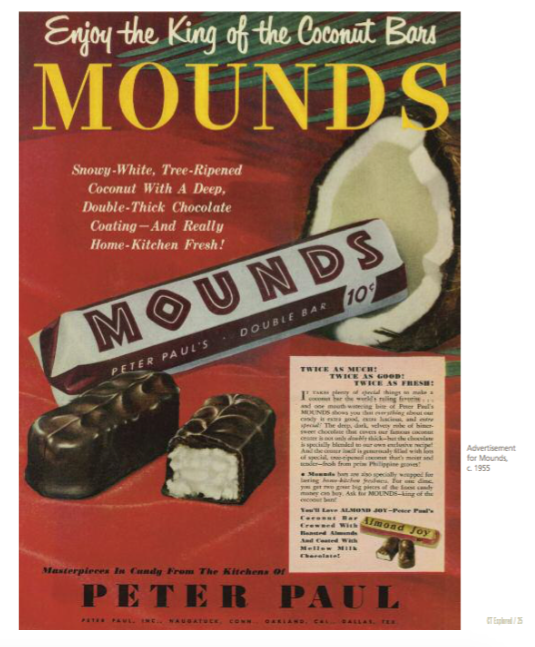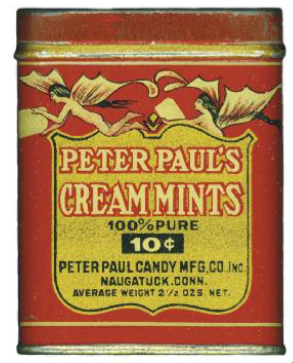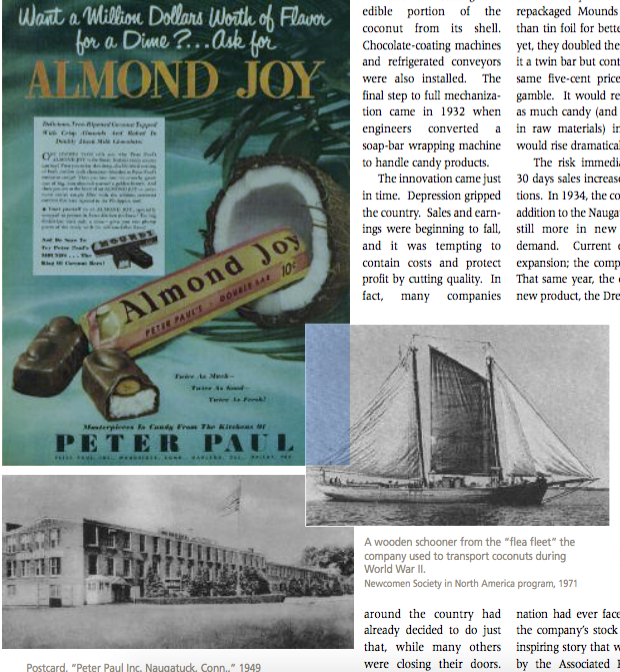Peter Paul’s Path to Sweet Success

Advertisement for Mounds, c. 1955. Museum of Connecticut History
“Sometimes you feel like a nut, sometimes you don’t.”
–Peter Paul Inc. advertising slogan
Peter Halajian came to the United States from Armenia in 1890. He worked in a rubber factory in Naugatuck. He dreamed of starting his own business.
To make extra money, he sold fruit and candy after work. He and his daughters sold homemade sweets to people waiting for the train. They also sold candy by going from house to house. People loved his sweet treats.
In 1895, Halajian was able to open a candy shop in Naugatuck. He sold peanut brittle, licorice, lemon drops, chocolates, and ice cream there.
His shop was successful, so he opened a shop in Torrington and another one in Naugatuck. He started advertising in the newspaper to get more customers. He made up clever slogans.
Customers had a hard time pronouncing his last name, so he changed it to Paul. His name was now Peter Paul. His brother-in-law, Cal Kazanjian, joined the growing business.
During World War I, the U.S. Army asked candy makers, including Peter Paul, to make chocolate bars for soldiers. After the war, Peter Paul wanted to expand his business.
In 1919, Paul and Kazanjian convinced four friends and family members to invest in their company. They were all Armenian immigrants.
They named the new company Peter Paul Manufacturing Company. The company moved to New Haven.
There were more than 6,000 candy companies in the United States! There was a lot of competition in the candy business. Paul and Kalajian needed to create a candy that was different from anyone else’s. They hired Harry Tatigian, a Bridgeport candy maker.

Cream mints, c. 1935. Museum of Connecticut History
In 1921, the Peter Paul Manufacturing Company introduced the Mounds candy bar. The Mounds bar had chocolate on the outside and coconut on the inside. It quickly became the company’s best-selling candy.
Mounds bars were handmade. Each bar had to be rolled, shaped, dipped in chocolate, and wrapped in foil. By 1922, the company needed a larger space for the business. They also needed better equipment. Naugatuck Bank gave them a loan to expand.
In 1927, Peter Paul died. Kazanjian became president of the company. The company continued to do well. But they had competition to worry about. Other companies made popular candy bars such as The Oh Henry!, Baby Ruth, and Milky Way bars.
The Peter Paul company decided to stop selling some of its other candy bars so it could focus on the Mounds bar. The company began using machines to make the bars. It sold the candy in a new wrapper. It also doubled the size of the candy but kept the cost at five cents.
Peter Paul became the world’s largest consumer of coconuts. It shipped out more than 100,000 pounds of candy a day!

Advertisement for Almond Joy, c. 1955; wooden schooner used to ship coconuts during World War II; postcard of the Peter Paul factory in Naugatuck, 1949. Museum of Connecticut History
World War II was a difficult time for many companies. Peter Paul could not get the ingredients it needed. Sugar was in short supply. So the company again stopped creating other candies so it could focus on Mounds. Mounds were sent to soldiers. Five million candy bars were sent to troops every month!
After the war, Peter Paul added an almond to the Mounds bar and created the Almond Joy. It was also a hit! Peter Paul advertised its products on the radio. It even became the first candy company to run a commercial on color television.
In 1978, the company was sold to Cadbury Schweppes for $58 million. The Naugatuck factory continued to make the candy. In 1988, the company was sold again to Hershey’s for $300 million.
Mounds and Almond Joy stopped being produced in Naugatuck in April 2007. Peter Halajian’s candy company will always be remembered as one of Connecticut’s most successful businesses.
This article is adapted from “Peter Paul’s Path to Sweet Success” by Gregg Pugliese, Connecticut Explored, Spring 2010.




